****************************************************************************
Mathematics 309 - Camera Lenses
PROPERTIES OF LENSES, OPTICAL GLASS
CompositionGlass is a solid, structureless and amorphous. There are
two main group classification of optical glass:
- Crown, and
- Flint (has a high content of lead oxide)
Chemicals are combined to produce new glass types. These new glass types are used to benefit other different
types of cameras (such as high-speed minature cameras, black/white cameras, etc).
Properties
The most important optical characteristics of a glass are its refractive index and its degree of dispersion.
Refraction is the phenomenon of a light ray that passes from air to glass or from glass to air, and is deflected from its
path when it meets the glass surface at an angle. The glasses magnitude depends on two things: the material of the glass
and its wavelength. We can see wavelengths as coloured light from (spectrum colours) red,
orange, yellow, green, blue,
indigo and violet. An example of this is the refraction of light on a raindrop, where we may see a rainbow.

|
Note, that the shorter the wavelength of the light, the more the ray strikes the glass surface is refracted. Blue and
violet rays are deflected more than red rays. The degree of the deflection is a case characterized by a value,
the refractive index n. It varies from the different colours of the spectrum. The degree of refraction is given by
Snellius's law of refraction:

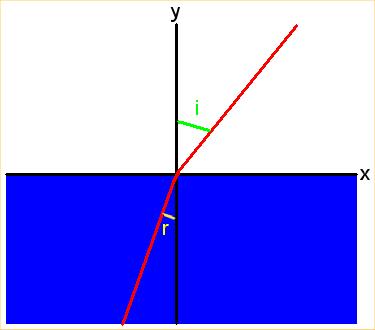
where r is the angle or refraction and i is the angle of incidence
The value of n for air is 1.00, water is 1.33, crown glass is 1.46 to 1.72 and flint glass is 1.55 to 1.80.
In a camera, light is transmitted by the aperture. It forms on the screen a circle of light
which is the image of the
object point. When the distance of the screen from the aperture is increased, the image will become larger as well as the
diameter of the circle of light (image point). The size of the aperature depends on the diameter of the circle of light
from the image. The light that passes the aperature is scattered or diffracted. So, if the aperature is too small,
the image may become less sharp because of the scatter of light at the aperature opening. A sharp image must have a
aperture large enough to reduce the effects of diffraction to a minimum.
Lens Shapes
A lens is a glass body bounded by two surfaces centred on the optical axis of the lens. There are two groups of lenses:
positive (or collecting) and negative (or diverging) lenses. Also, the lens surface can be proud (convex), hollow
(concave) or plane. The following is six basic shapes:
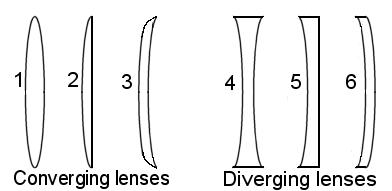
- Biconvex is two convex surfaces
- Plano-convex is a convex and plane surface
- Positive meniscus is a convex and concave surface (radius of convex surface is smaller,
thus stronger curve)
- Biconcave is two concave surfaces
- Plano-concave is a concave and plane surface
- Negative meniscus is a concave and convex surface (radius of concave surface is smaller)
Positive Lenses make a light beam converge and reduce its diameter. Negative lenses make the light beam diverge after
passing through the lens.
Simple Camera, with simple lenses
In photographic optics only the simplest cameras uses a single lens for image formation. The
focal length determines
the size of the image (the longer the focal length the larger the image). As an example, lets assume
that the optical system consists of two thin lenses of focal lengths  and
and  .
Where
.
Where  is the object-lens distance and
is the object-lens distance and  is the lens-image distance. Let
is the lens-image distance. Let  , be the
distance between the two lenses. Let
, be the
distance between the two lenses. Let  be the required focal length of the whole system give by
the equation:
be the required focal length of the whole system give by
the equation:
 Note as
Note as  becomes larger, the focal length
becomes larger, the focal length  increases and the farther the two lenses are
separated. The Gaussian equation also measures focal length:
increases and the farther the two lenses are
separated. The Gaussian equation also measures focal length:
 where
where  and
and  are the focal distances,
are the focal distances,  and
and  are
the radii of the two lens surfaces and n is the refractive index of the lens.
are
the radii of the two lens surfaces and n is the refractive index of the lens.
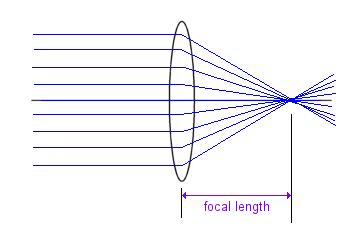
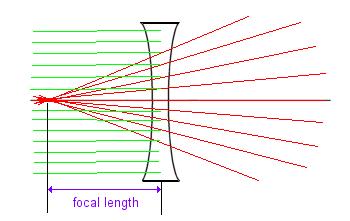 The left is a convex lens and the right is a concave lens; green lines represent light.
Note that lenses with longer focal lengths are associated with zoom lenses.
The left is a convex lens and the right is a concave lens; green lines represent light.
Note that lenses with longer focal lengths are associated with zoom lenses.
The diameter of a lens controls the amount of light collected. A smaller lens does not collect as much light than a
larger one shown in this picture:

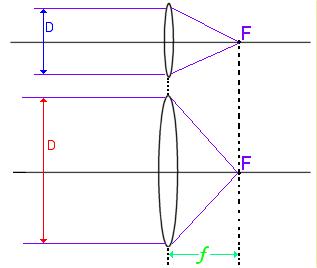 where the focal length is the same and the diameter of the lens varies.
Aperature can be compared to the iris of an eye.
The relative aperture of a lens is the speed of the lens. Its ratio of its diameter to the focal length is:
where the focal length is the same and the diameter of the lens varies.
Aperature can be compared to the iris of an eye.
The relative aperture of a lens is the speed of the lens. Its ratio of its diameter to the focal length is:
 "OR"
"OR"
 If
If  =1.5, we interpret that the focal length of the lens is 1.5 times as large as its diameter;
or the lens diameter is in the ratio of 1:1.5 to the focal length. It is measured by f-number.
=1.5, we interpret that the focal length of the lens is 1.5 times as large as its diameter;
or the lens diameter is in the ratio of 1:1.5 to the focal length. It is measured by f-number.
The aperture number determines the angular aperture . The angular aperture is the angle at which rays
pass through the edge of the lens. In a camera, aperture is controlled by the use of diaphragm blades which may be curved
metal or hard rubber strips. It is fixed by the setting which controls the the central opening to be larger or smaller in
size. The lens stop not only controls the light transmission of the optical system but influences the sharpness of the
picture. Also, it can influence image definition by cutting out the marginal rays of the lens.
ABBERATIONS AND THEIR CORRECTIONS
Optical abberations is an inaccurate image reproduction associated with the lenses or an error of the aberration of
magnification. As a result, you may get blurred image edges, distortion at the margins of the picture area and a lack of
sharpness in the picture. These aberrations can be eliminated by combining several lenses to form a less complex lens
system.
Chromatic abberations
Chromatic abberations occurs when different coloured focal points are arranged behind each other on the optical
axis, with the blue focal point nearest to the lens. This can also be called an under-corrected lens defect.
Sometimes, the refractive index for all optical glasses is greater for blue light rays of short wavelength than for red
rays of long wavelength. As a result the light passing through a converging lens may not meet in a common focus.
Conversely, with diverging lenses the red rays have the greater focal distance than the blue-violet one, which is called
over-correction. What we learn is that every lens has different image distances and focal lengths for light of
every colour (every light colour has its own image as well).
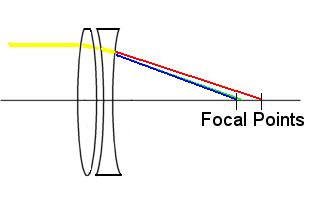
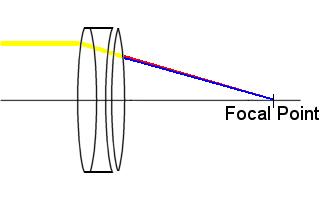 To correct this flint glass and crown glass are combined. We know that flint glass has a greater refraction (thus
greater refraction angle) than a crown glass. So a crown glass converging lens with a flint glass diverging lens enables
the dispersion of the two lenses to compensate each other to a certain extent, without cancelling their refractive powers.
This neutralizes the chromatic faults. However, this only solves the problem for two colours, having errors in other
colours (yellow and green), this is called secondary aberrations. This is corrected by choosing specially
selected glass types for the two lens elements or adding another lens. The photo is distorted by Chromatic
abberations and if you place your mouse cursor on the picture it will corrected (magically!):
To correct this flint glass and crown glass are combined. We know that flint glass has a greater refraction (thus
greater refraction angle) than a crown glass. So a crown glass converging lens with a flint glass diverging lens enables
the dispersion of the two lenses to compensate each other to a certain extent, without cancelling their refractive powers.
This neutralizes the chromatic faults. However, this only solves the problem for two colours, having errors in other
colours (yellow and green), this is called secondary aberrations. This is corrected by choosing specially
selected glass types for the two lens elements or adding another lens. The photo is distorted by Chromatic
abberations and if you place your mouse cursor on the picture it will corrected (magically!):
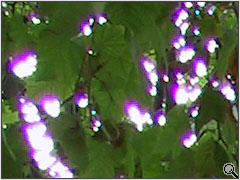
Pin-cushion distortion and Barrel distortion
An image fault, or distortion, can occur if the image produced by an optical system does not strictly correspond in
geometry to the object it is derived from.
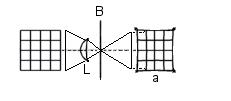
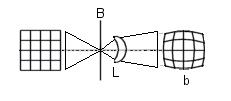 where B is the aperature and L is the lens; a is pin-cushion distortion and b is barrel distortion
where B is the aperature and L is the lens; a is pin-cushion distortion and b is barrel distortion
A lens may not be distorted if the scale of reproduction (or magnification) is the same for all image points. The scale of
reproduction must be constant at all inclinations of the principal ray within the angle of view
. The ratio is as follows:
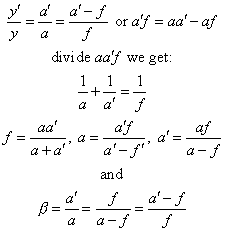 Distortion occurs when the object is a distance and the rays from the corners of the object to the center
of the lens aperture then are at a greater angle to the optical axis than the rays from the middle of the sides of the
square. If the direction of theses rays is different for larger angles than for smaller ones, we get a shape with its
edges curved inwards or outwards.
Distortion occurs when the object is a distance and the rays from the corners of the object to the center
of the lens aperture then are at a greater angle to the optical axis than the rays from the middle of the sides of the
square. If the direction of theses rays is different for larger angles than for smaller ones, we get a shape with its
edges curved inwards or outwards.
For a pin-cushion distortion the scale of reproduction increases from the centre to
the edges. The image with its sides pushed inwards. This occurs when the lens stop is situated behind the lens.
For a barrel distortion the image magnification decreases with increasing
object size. this occurs when the lens stop is in front of the lens.
Distortion can be eliminated by symmetrically arranging two systems consisting of a front and rear component about a
central stop.
TYPES OF LENSES
Normal Camera Lenses
Most standard cameras today have a 35mm lens. 35mm lens refers to the diameter of the lens. The smaller diameter the
lens makes for better photos from far away (wide-angle lenses) and larger diameter of the lens is better for photos
that you are wanting to take from a distance (zoom lenses). The reason why a 35mm is most common camera is because it
is the most versatile lens for everyday photos.
Wide-angle Lenses
Lenses with great angle are known as wide-angle lenses. At the lens the diagonal of all such lenses therefore
subtends more or less the same angle, the angle of view (is between 40 to 60 degrees). If the focal length is short,
the image plan moves nearer to the lens, and a greater angle of view is required to cover the same picture format.
An average wide-angle lens may cover up to 70 to 80 degrees. Some can even go beyond 180 degrees.
A wide-angle lenses may look like the following:
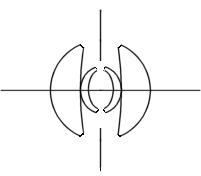 This is a Nikkor 21mm f/4 (Nikon) lens.
This is a Nikkor 21mm f/4 (Nikon) lens.
A wide-angle lens is needed wherever you want to take a picture sufficiently far from the subject. For example, if you
want to take a picture of a large building, narrow street, etc, this is a good lens to use because it takes a greater
angle of the view. The scale of reproduction is of course smaller than with a normal (standard) lens. One problem that
occurs with a wide-angle lens is it usually has a large amount of barrel distortion. This occurs if the angle of view
approaches 180 degrees, the size of film will be infinitely large, therefore difficult to overcome.
Zoom Lenses
Using the equation for magnification, the total focal length becomes shorter as the distance between the two components is
reduced. With multi-component systems it is possible to adjust teh focal length by displacing individual lenses. Lenses
with variable focla length have developed which permit the coninuous adjustment of the image scale, preserving a given
distance setting between the subject and the image. This type of lenses was first made for cine cameras and was later
developed for reflex cameras. The simpliest zoom lens can consist of only a single positive and negative lens. The
positive lens would be used to increase/decrease the focal length and the negative lens would help to focus the image.
An example of a more complicated zoom lenses is the Voigtlander Zoomar:
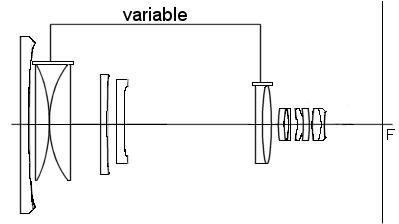 It composes of fourteen different lenses and 11 components. The one to the right is at a wide-angle position. The one
to the right is at a tele-position, or zoom focus. The two moving components allow use to change the focal lengths. It
covers a 62 degree angle in the wide-angle position and 30 degrees for the tele-position.
It composes of fourteen different lenses and 11 components. The one to the right is at a wide-angle position. The one
to the right is at a tele-position, or zoom focus. The two moving components allow use to change the focal lengths. It
covers a 62 degree angle in the wide-angle position and 30 degrees for the tele-position.
****************************************************************************
Works Cited
By Debbie Loo
****************************************************************************




 and
and  .
Where
.
Where  , be the
distance between the two lenses. Let
, be the
distance between the two lenses. Let  be the required focal length of the whole system give by
the equation:
be the required focal length of the whole system give by
the equation:


 are the focal distances,
are the focal distances,  and
and  are
the radii of the two lens surfaces and n is the refractive index of the lens.
are
the radii of the two lens surfaces and n is the refractive index of the lens.




 "OR"
"OR"

 =1.5, we interpret that the focal length of the lens is 1.5 times as large as its diameter;
or the lens diameter is in the ratio of 1:1.5 to the focal length. It is measured by f-number.
=1.5, we interpret that the focal length of the lens is 1.5 times as large as its diameter;
or the lens diameter is in the ratio of 1:1.5 to the focal length. It is measured by f-number.







